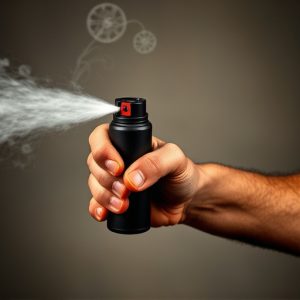Riot Control Agents: Law Enforcement’s Tools and Future Tactics
Pepper spray, a common riot control agent, loses effectiveness in rainy conditions due to water dilu…….
Pepper spray, a common riot control agent, loses effectiveness in rainy conditions due to water diluting its active ingredient, capsaicin. Research shows reduced range and impact during heavy rain or high humidity, leading to the need for alternative tactics. Law enforcement is exploring "next-generation" agents that perform better in diverse weather, prioritizing safety and citizen well-being over pepper spray's limited effectiveness in rain.
Riot control agents, particularly pepper spray, have long been a cornerstone of law enforcement strategies worldwide. This article delves into the legal perspective of these powerful tools, examining their effectiveness and evolving role in maintaining public order. We explore specific challenges posed by wet conditions, with a focus on pepper spray’s performance in the rain. Additionally, we look towards future tactics, considering alternatives that go beyond traditional pepper spray.
- Understanding Riot Control Agents: A Legal Perspective
- Pepper Spray in Wet Conditions: What Science Says
- The Future of Law Enforcement Tactics: Beyond Pepper Spray
Understanding Riot Control Agents: A Legal Perspective
Riot control agents, including pepper spray, are chemical substances designed for law enforcement to manage and disperse crowds during civil unrest or large-scale events. From a legal standpoint, understanding their effectiveness and appropriate use is paramount. Pepper spray, in particular, has gained significant attention for its ability to temporarily disable individuals through the irritation of eyes, respiratory system, and skin. However, its performance can be influenced by environmental factors such as weather conditions, notably rain.
In terms of pepper spray effectiveness in rain, studies show that water can dilute the active ingredients, reducing their potency. Rain may also affect the spraying mechanism and range of the agent. These variables underscore the importance of training for law enforcement officers to ensure they use these agents responsibly and proportionately, adhering to legal guidelines and minimizing unintended consequences.
Pepper Spray in Wet Conditions: What Science Says
Pepper spray, a common riot control agent used by law enforcement, has long been debated for its effectiveness in wet conditions, particularly during rainy weather. When deployed, pepper spray creates a cloud of capsaicin, the active ingredient that causes intense irritation and temporary blindness. However, water presents a unique challenge. Studies show that pepper spray’s effectiveness can be significantly reduced in high humidity or rain due to the neutralization of its chemical composition.
The scientific community has found that water molecules can dissolve and disperse the capsaicin, leading to a faster breakdown of the spray’s potency. In wet conditions, the spray’s range and impact are often diminished, as the capsicum particles become less concentrated. This discovery has implications for law enforcement strategies, suggesting the need for alternative tactics or complementary tools when operating in environments with high moisture levels, such as heavy rain.
The Future of Law Enforcement Tactics: Beyond Pepper Spray
The future of law enforcement tactics involves evolving beyond traditional riot control agents like pepper spray, which has long been a staple for managing crowd disturbances and controlling protests. While pepper spray is effective in many scenarios, its performance can be impacted by environmental factors such as rain. In wet conditions, the active ingredient’s concentration and potency decrease significantly, reducing its overall effectiveness. This presents an opportunity for law enforcement agencies to explore alternative strategies that are more suitable for diverse weather conditions.
Research and development are focused on creating next-generation riot control agents that offer improved performance in various environments, including rain. These innovative solutions aim to provide officers with tools that can better control and disperse crowds without compromising safety or effectiveness. By embracing these advancements, law enforcement agencies can enhance their capability to manage dynamic situations while ensuring the well-being of both officers and citizens.
Riot control agents, particularly pepper spray, have been a cornerstone of law enforcement for decades. However, as tactics evolve and scientific understanding advances, it’s crucial to consider the future of these tools. While pepper spray has proven effective in various scenarios, including wet conditions, as demonstrated by recent studies on Pepper Spray Effectiveness in Rain, there is a growing need to explore alternative options beyond traditional chemical agents. By balancing public safety with the pursuit of non-lethal, less harmful alternatives, law enforcement can navigate the challenges of modern urban environments and foster communities built on trust and de-escalation.


